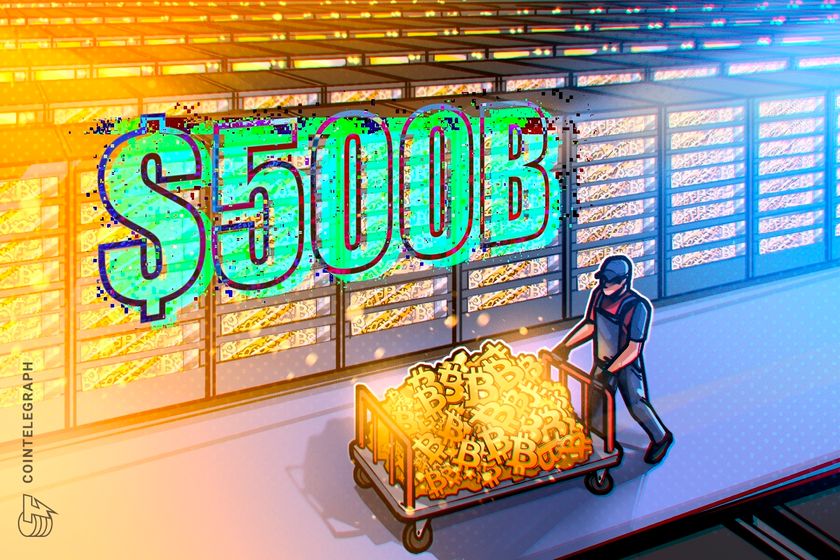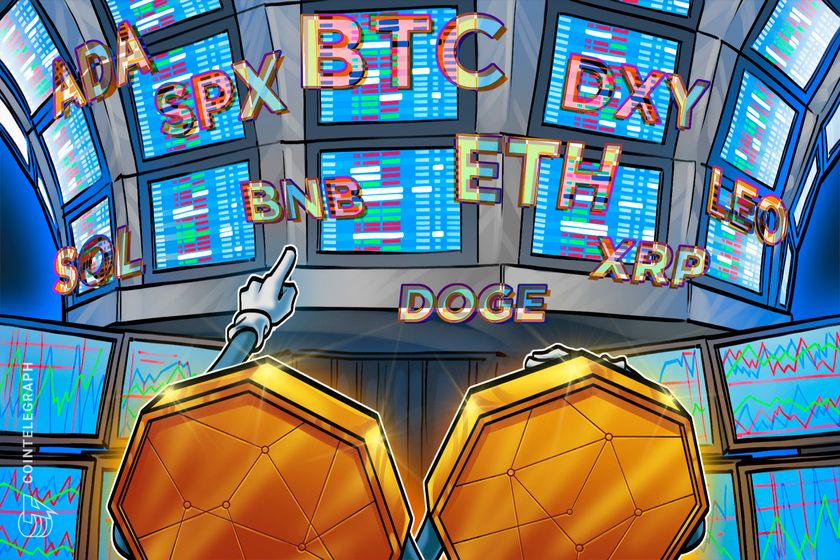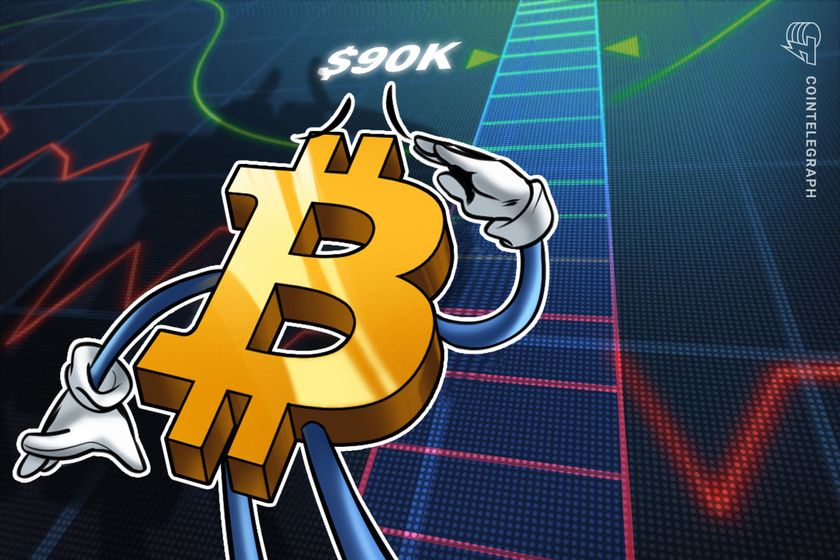Indice de peur et avidité
Top 7 des gagnants
| Cryptomonnaie | Changement sur 24 heures |
|---|---|
 Fartcoin (fartcoin) Fartcoin (fartcoin) | 7.05% |
 Monero (xmr) Monero (xmr) | 4.55% |
| 4.33% | |
 Algorand (algo) Algorand (algo) | 2.95% |
 Render (render) Render (render) | 2.05% |
 NEXO (nexo) NEXO (nexo) | 1.92% |
 Avalanche (avax) Avalanche (avax) | 1.75% |
Top 7 des perdants
| Cryptomonnaie | Changement sur 24 heures |
|---|---|
 Ethena (ena) Ethena (ena) | -7.96% |
| -7.49% | |
 Official Trump (trump) Official Trump (trump) | -6.53% |
 Bitcoin Cash (bch) Bitcoin Cash (bch) | -5.68% |
 Jupiter (jup) Jupiter (jup) | -5.37% |
 Artificial Superintelligence Alliance (fet) Artificial Superintelligence Alliance (fet) | -4.14% |
 Internet Computer (icp) Internet Computer (icp) | -4.1% |


The US Treasury has injected $500 billion into financial markets since February by drawing liquidity from its Treasury General Account (TGA), funding government operations after a $36 trillion debt ceiling was hit on Jan. 2, 2025.
Macroeconomic financial analyst Tomas said that this liquidity surge boosted the net Federal Reserve liquidity to $6.3 trillion, and it may support Bitcoin’s (BTC) price in the future, even though risk assets have reflected minimal growth so far.
US Treasury General Account’s expected liquidity flow. Source: X.com
The TGA represents the government’s checking account at the Federal Reserve, holding capital for daily operations like paying bills or collecting taxes. A decrease in TGA capital means the balance has been deployed into the broader economy, boosting available cash in the markets.
Tomas explained that The TGA drawdown commenced on Feb. 12, following the exhaustion of "extraordinary measures" after the debt ceiling was reached. The TGA balance has dropped from $842 to roughly $342 billion, releasing liquidity into the system, and the targeted liquidity is expected to rise up to $600 billion by the end of April.
The analyst added that the current tax season will temporarily drain liquidity, but the drawdown is expected to resume in May. If debt ceiling talks extend to August, net liquidity could hit a multi-year high of $6.6 trillion, which could cause a bullish tailwind for Bitcoin.
Bitcoin’s correlation with global liquidity. Source: Lynalden.com
According to a study by financial analyst Lyn Alden, Bitcoin has historically moved 83% of the time in line with global liquidity in a given 12-month period. The research termed “Bitcoin a Global Liquidity Barometer” compared Bitcoin to other major asset classes such as SPX, gold and VT, and BTC topped the correlation index with respect to global liquidity.
Past TGA drawdowns in 2022 and 2023 have fueled speculative assets like Bitcoin. Thus, a $600 billion boost, plus billions more added over Q2-Q3, could lift BTC’s value if market conditions remain stable.
Related: Bitcoin traders target $90K as apparent tariff exemptions ease US Treasury yields
Bitcoin eyes $137,000 by Q2-Q3, says analyst
Anonymous crypto trader Titan of Crypto shared a bullish outlook for Bitcoin, predicting that BTC could surge to a new all-time high of $137,000 by July-August 2025. In a recent X post, the analyst pointed out a bullish pennant pattern on the daily chart, with the price potentially heading toward a positive breakout.
Bitcoin bullish pennant by Titan of Crypto. Source: X.com
However, before pushing chips into a long conviction play, BTC must break and retain a position above its 200-day exponential moving average (EMA). As illustrated in the chart, Bitcoin faces resistance from all three key EMAs, namely, the 50-day, 100-day and 200-day indicators.
A collective reclaim above each moving average on a higher time frame chart could further strengthen the bullish case, allowing the crypto to retest its six-figure targets.
Bitcoin 1-day chart analysis. Source: Cointelegraph/TradingView
Related: Bybit integrates Avalon through CeFi to DeFi bridge for Bitcoin yield
This article does not contain investment advice or recommendations. Every investment and trading move involves risk, and readers should conduct their own research when making a decision.


Bitcoin (BTC) bulls are trying to start the week on a positive note by pushing the price above $85,000. Michael Saylor’s Strategy has used the recent dip to buy 3,459 Bitcoin for $285.5 million at an average price of $82,618. That boosts the total holding of the firm to 531,644 Bitcoin purchased at an average price of $67,556.
However, not everyone is bullish in the near term. Several institutional investors seem to have trimmed their holdings. CoinShares reported on April 14 that digital asset exchange-traded products (ETPs) witnessed $795 million in outflows last week. The $7.2 billion in outflows since February have reversed nearly all year-to-date inflows, now at just $165 million.
Daily cryptocurrency market performance. Source: Coin360
Although Bitcoin seems to have bottomed out in the short term, a roaring bull market rally is unlikely to start in a hurry. The tariff headlines and the outcome of the tariff talks between the United States and other countries could dictate the price action.
Could Bitcoin build upon the recovery, pulling altcoins higher? Let’s analyze the charts to find out.
S&P 500 Index price analysis
The S&P 500 Index (SPX) witnessed a hugely volatile week, but a positive sign is that lower levels attracted solid buying by the bulls.
SPX daily chart. Source: Cointelegraph/TradingView
After the massive volatility of the past few days, the index could enter a quieter phase. Sellers are likely to sell the rallies near 5,500, while the bulls are expected to buy the dips to the 5,119 support. That signals a possible range-bound action between 5,500 and 5,119 for some time.
The next trending move is expected to begin after buyers push the price above 5,500 or sink below 4,950. If the 5,500 level gets taken out, the index could surge to 5,800.
US Dollar Index price analysis
The US Dollar Index (DXY) has been in a freefall since turning down from the 20-day exponential moving average (102.81) on April 10.
DXY daily chart. Source: Cointelegraph/TradingView
Buyers defended the 99.57 level on a closing basis on April 11, but the bears renewed their selling on April 14. If the price closes below 99.57, the index could tumble to 97.50 and, after that, to 95. The longer the price remains below 99.57, the greater the risk of starting a new downtrend.
If buyers want to prevent a downward move, they will have to swiftly push the price back above 99.57. That could start a recovery to 101.
Bitcoin price analysis
Bitcoin broke above the resistance line on April 12, and the bulls successfully held the retest of the breakout level on April 13.
BTC/USDT daily chart. Source: Cointelegraph/TradingView
The 20-day EMA ($82,979) has flattened out, and the RSI is near the midpoint, suggesting that the selling pressure is reducing. The BTC/USDT pair could climb to $89,000, which is likely to act as a stiff resistance. If the price turns down sharply from $89,000 and breaks below the 20-day EMA, it will indicate a range formation. The pair may oscillate between $89,000 and $73,777 for a few days.
If sellers want to trap the aggressive bulls and retain control, they will have to quickly pull the price back below the 20-day EMA. If they do that, the pair may descend to $78,500 and subsequently to the vital support at $73,777.
Ether price analysis
Ether (ETH) is facing selling at the 20-day EMA ($1,722), as seen from the long wick on the April 14 candlestick.
ETH/USDT daily chart. Source: Cointelegraph/TradingView
If the price plummets below $1,546, the ETH/USDT pair could retest the $1,368 support. This is a crucial level for the bulls to defend because a break below $1,368 could start the next leg of the downtrend toward $1,150.
Conversely, if buyers propel the price above the 20-day EMA, it signals that the bears are losing their grip. There is resistance at the 50-day SMA ($1,955), but it is likely to be crossed. The pair may then ascend to the solid resistance at $2,111.
XRP price analysis
XRP (XRP) turned down from the 50-day SMA ($2.24) on April 13, indicating that sellers are active at higher levels.
XRP/USDT daily chart. Source: Cointelegraph/TradingView
The 20-day EMA ($2.10) has flattened out, and the RSI is near the midpoint, indicating a balance between supply and demand. A break below $2 will tilt the advantage in favor of the bears. The XRP/USDT pair could drop to $1.72 and later to $1.61.
Buyers will gain the upper hand if they push and maintain the price above the 50-day SMA. If they can pull it off, the pair could rally to the resistance line. Sellers are expected to aggressively defend the resistance line because a break above it signals a potential trend change.
BNB price analysis
BNB (BNB) is facing resistance at the downtrend line, but a minor positive is that the bulls have not ceded much ground to the bears.
BNB/USDT daily chart. Source: Cointelegraph/TradingView
That increases the likelihood of a break above the downtrend line. If that happens, the BNB/USDT pair could ascend to $645. Sellers will try to guard the $645 level, but it is likely to be crossed.
This positive view will be invalidated in the near term if the price turns down sharply from the downtrend line and breaks below $566. That could keep the pair stuck inside the triangle for a while longer.
Solana price analysis
Sellers are trying to defend the 50-day SMA ($130) in Solana (SOL), but the bulls have kept up the pressure.
SOL/USDT daily chart. Source: Cointelegraph/TradingView
If the price closes above the 50-day SMA, the SOL/USDT pair could rise to the $147 to $153 resistance zone. Sellers are expected to vigorously defend this zone, but if the bulls prevail, the pair could surge to $180.
The first support on the downside is the 20-day EMA ($123). A bounce off the 20-day EMA will keep the positive momentum intact, while a break below it could sink the pair to $110 and eventually to $95.
Related: Solana rallies 20% against Ethereum, but is $300 SOL price within reach?
Dogecoin price analysis
Buyers are trying to start a recovery in Dogecoin (DOGE) but are expected to face stiff resistance from the bears at the moving averages.
DOGE/USDT daily chart. Source: Cointelegraph/TradingView
If the price turns down from the moving averages, the bears will again attempt to sink the DOGE/USDT pair below $0.14. If they manage to do that, the selling could accelerate, and the pair may slump to $0.10.
Contrarily, if buyers propel the price above the moving averages, the pair could rally to $0.20. This is an important near-term level to watch out for because a break above it will complete a double-bottom pattern. The pair could then climb toward the pattern target of $0.26.
Cardano price analysis
Buyers are struggling to push Cardano (ADA) above the 20-day EMA ($0.65), indicating that demand dries up at higher levels.
ADA/USDT daily chart. Source: Cointelegraph/TradingView
If the price turns down from the 20-day EMA, the next support on the downside is $0.58 and then $0.50. Buyers are expected to fiercely defend the $0.50 level because a break below it could sink the ADA/USDT pair to $0.40.
On the upside, buyers will have to drive and maintain the price above the 50-day SMA ($0.71) to signal that the downtrend could be over. That could propel the pair to $0.83 and subsequently to $1.03.
UNUS SED LEO price analysis
Buyers are trying to push UNUS SED LEO (LEO) above the 20-day EMA ($9.39), but the bears are posing a substantial challenge.
LEO/USD daily chart. Source: Cointelegraph/TradingView
The flattening 20-day EMA and the RSI near the midpoint suggest a balance between supply and demand. That could keep the LEO/USD pair stuck between $9.90 and $8.79 for a few days.
The next trending move could begin on a break above $9.90 or below $8.79. If buyers kick the price above $9.90, the pair will complete a bullish ascending triangle pattern. This bullish setup has a target objective of $12.04.
On the downside, a break below $8.70 could signal the start of a deeper correction toward $8.30.
This article does not contain investment advice or recommendations. Every investment and trading move involves risk, and readers should conduct their own research when making a decision.
style u003d "float: droit ; marge: 0 0 10px 15px ; largeur: 240px ; " >
La Commission des valeurs mobilières et de l'échange des États-Unis (Sec ) a retardé une décision sur l'opportunité d'approuver le stimulation éther en deux fonds à gris.
La décision sur Grayscale Etf ETF et Grayscale Etf ETF a été reportée jusqu'au 1er juin, a CCording À un annoncement du 14 avril de la SEC. La date limite pour une décision est fin octobre.
Le 14 février, la Bourse de New York (NYSE ) a déposé un changement de règle proposé sur Behalf de Grayscale qui permettrait aux investisseurs de la société & rsquo ; data-cct-non-brisemblable u003d "null " href u003d "/ Ethereum-price " rel u003d "null " cible u003d "null " text u003d "null " title u003d "/ Ethereum-price " > eth ) etfs pour accéder à leurs collectes.
sec & rsquo ; s annonce du retard. Source: sec
Le rendement annuel sur le rendement annuel sur le stimulation >
Le rendement annuel sur le stimulation > est estimé sur 2.4 sur le rendement annuel sur le stip Coinbase, alors que sur Kraken, un autre échange basé aux États-Unis, varie de 2% à 7%. Selon Sosovalue, les ETF éther ont a eu a cumulaire de Null de "Null ". milliards depuis leur lancement en 2024.
La course à la mise sur les ETF Ether comprend d'autres gestionnaires d'actifs, y compris BlackRocks


The 2-year and 10-year US Treasury yields dipped on Monday, April 14, after Bitcoin (BTC) closed its best weekly performance since the second week of January. Bitcoin gained 6.79% over the past week, but are enough factors aligned to support continued price upside?
The 10-year treasury yield declined by 8.2 basis points to 4.40% during the New York trading session, while the 2-year treasury saw an 8 basis point slip to 3.88%. The drop in yields occurred on the back of possible tariff exemptions on smartphones, computers, and semiconductors, which were introduced to give US companies time to move production domestically. However, US President Donald Trump emphasized these exemptions were temporary in nature.
US 10-year treasury bond yields chart. Source: Cointelegraph/TradingView
The tariff exemptions announced on April 12 came at the end of a bullish week for Bitcoin. After forming new yearly lows at $74,500, BTC price jumped 15% to $86,100 between April 9-13.
Easing US treasury yields could be a double-edged sword for Bitcoin. Lower yields reduce the appeal for fixed-income assets, improving capital injection into risk-on assets like BTC. Still, the uncertainty of “temporary exemptions” and the ongoing trade war with China keeps Bitcoin susceptible to further price volatility.
As an “inflation hedge,” Bitcoin continues to draw mixed opinions, but recent uncertainty over trade policies increases inflation fears, improving BTC’s store of value narrative. Yet, recent US inflation data suggested a cooling trend, as the Consumer Price Index (CPI) for March 2025 indicated a year-over-year inflation rate of 2.4%, down from 2.8% in February, marking the lowest since February 2023, which could be indirectly bearish for Bitcoin in the short term.
Related: Trade war vs record M2 money supply: 5 things to know in Bitcoin this week
Bitcoin price hurdles present at $88K to $90K
Trading resource Material Indicators noted that Bitcoin retained a bullish position above its 50-weekly moving average and quarterly open at $82,500. A strong weekly close implied a higher possibility that Bitcoin is less likely to re-visit its previous weekly lows anytime soon. The analysis added,
“Bitcoin bulls now face strong technical and liquidity-based resistance between the trend line and the 200-day MA. Expecting “Spoofy” to move asks at $88k and $92k before they get filled.”
Likewise, Alphractal founder Joao Wedson suggested that Bitcoin may be nearing a bullish reversal, as the Perpetual-Spot Gap on Binance—a key indicator tracking the price difference between Bitcoin’s perpetual futures and spot markets, has been narrowing since late 2024.
Bitcoin Perpetual-spot price gap chart. Source: X.com
In a recent X post, Wedson highlighted that this shrinking gap, currently negative, signals fading bearish sentiment, with historical trends from 2020–2021 and 2024 showing that a positive gap often leads to a Bitcoin rally. Wedson noted that a flip to a positive gap could indicate returning buyer momentum. However, he cautioned that such negative gaps persisted during the 2022–2023 bear market.
Related: Michael Saylor’s Strategy buys $285M Bitcoin amid market uncertainty
This article does not contain investment advice or recommendations. Every investment and trading move involves risk, and readers should conduct their own research when making a decision.


Mantra CEO John Mullin addressed key concerns from the community following the sharp decline in the OM token during an Ask Me Anything (AMA) session hosted by Cointelegraph on April 14.
Mullin reassured users that Mantra and its partners are actively working to support the recovery of the Mantra (OM) token, though he noted that details around token buybacks and potential burns are still being developed.
“We’re still in the early stages of putting together this plan for potential buyback of tokens,” the CEO said, adding that the OM token recovery is Mantra’s “preeminent and primary concern right now.”
At the time of writing, OM traded at $0.73, slightly higher than its post-collapse low of $0.52 recorded on April 13 at around 7:30 pm UTC, according to data from CoinGecko.
“Baseless allegations”
In addition to denying reports claiming that key Mantra investors dumped the OM token pre-crash, the Mantra CEO also denied allegations that the Mantra team controls 90% of the token’s supply.
“I think it’s baseless. We posted a community transparency report last week, and it shows all the different wallets,” Mullin said, highlighting the “two sides” of Mantra’s tokenomics.
Source: Cointelegraph
“You have the Ethereum side and you have the mainnet side,” Mullin noted, adding the Ethereum-based token is hard capped and has been around since August 2020.
“The biggest holder of OM on exchange is Binance,” Mullin continued, referring the public to Etherscan records.
The top eight addresses of OM holdings. Source: Etherscan
However, the top OM wallet is currently held by crypto exchange OKX, which controls 14% of the circulating supply, or roughly 130 million tokens.
What’s next for Mantra’s $109-million MEF fund?
Mullin also addressed the Mantra Ecosystem Fund (MEF), a $109-million fund launched on April 7 in collaboration with its major strategic investors, including Laser Digital and Shorooq.
Other investors in the fund also included Brevan Howard Digital, Valor Capital, Three Point Capital, Amber Group, Manifold, UoB Venture, Damac, Fuse, LVNA Capital, Forte and others.
Related: Mantra bounces 200% after OM price crash but poses LUNA-like ‘big scandal’ risk
According to Mullin, the fund does not solely consist of Mantra’s OM token and has “dollar commitments and dollar contributions.”
Investors in Mantra’s $109-million fund. Source: Mantra
“We’ll continue to invest and support the ecosystem as part of this recovery plan,” the CEO stated.
End of the staking program on Binance
In the AMA, the Mantra CEO also said that a 38-million-OM transaction to the Binance cold wallet on April 14 is related to a staking program on Binance.
“It was actually Binance,” Mullin said, adding that Binance had OM tokens on its exchange that it was using as a staking program.
Source: Onchain Lens
“So, they just returned them because the staking program ended,” he said.
Mullin also emphasized that many of the transactions that caught the community’s reactions post-crash involved collaterals by an unnamed exchange.
“Effectively, those tokens were being used as collateral on an exchange. Then, the exchange decided that it was not the position they wanted to maintain anymore, for whatever reason,” Mullin said, adding:
“So, what happened was basically the positions were taken over by the exchange that took the collateral and started selling, which caused a cascade of sell pressure and forced more liquidations.”
Mullin said Mantra remains committed to addressing the situation as transparently as possible.
“We’re not running from anything,” he said, adding that the incident was a “very unfortunate situation.”
Magazine: Bitcoin eyes $100K by June, Shaq to settle NFT lawsuit, and more: Hodler’s Digest, April 6–12


Opinion by: Leroy Hofer, co-founder and CEO at Teneo Protocol
As the old wisdom goes, nobody knows you’re a dog on the internet. Often enough, nobody knows if you’re a bot either, to the point where the dead internet theory sometimes feels disturbingly tangible.
Bot traffic share hit its highest level in 2024, up 2% on the year before, according to the 2024 Imperva Bad Bot Report. The bot pandemic is ravaging the Web. People are taking notice — people like Chanpeng Zhao, for example, who recently urged Elon Musk to ban bots on X. He’s not the only one in the Web3 community to call for such measures, and rightly so.
From artificially inflating engagement metrics to orchestrating scams, bots are quickly drowning out real human interactions — and it’s at a time when our lives drift more and more into the online world.
While platform owners continue to roll out AI-driven moderation and paywalls to curb bot activity, these solutions fail to address the root problem. Moderation tools also regularly operate with minimal transparency — incorrectly flagging legitimate content without users knowing why.
Users also often have to surrender personal data to prove they are not bots, raising privacy concerns and creating barriers to participation. More problems are being made, and a decentralized approach is the only viable path forward.
If left to fester, the rise of bots will create repercussions that go way beyond social media. Companies pouring money into digital marketing will see their budgets wasted on fake engagement. It’s even possible to imagine a dirty trick where a rival would use bots to waste the competitor’s money by feeding them fake impressions — this already happens in the digital ad space.
People are — and will continue to become — more suspicious of online interactions, making it harder for authentic creators and businesses to earn trust. The user experience also suffers. As automated noise drowns out meaningful discussions, users may eventually abandon social media for good. We need to deal with the bot problem for all these and other reasons — once and for good.
The limits of centralized solutions
Social media giants have been using centralized moderation strategies to tackle the bots issue for quite some time. AI-driven detection systems serve as the first line of defense. They’re far from perfect. Bots are getting smarter, often slipping through the cracks by mimicking human behavior and bypassing safeguards. On top of that, false positives can lead to unfair restrictions on genuine users. Oh, the mighty banhammer, a weapon from a more civilized age.
Recent: CZ urges Elon Musk to ban bots on the X social media platform
Another common tactic is the implementation of paywalls, like X’s verification fees, which require users to pay for authentication. This method raises the financial hurdle for bot operators but also creates a two-tiered system that disadvantages users who can’t — or won’t — pay. Paywalls do little to deter well-funded bot farms that can easily overlook these costs. While these measures are well-meaning, they often miss the mark when balancing security with user accessibility.
A decentralized solution
A decentralized model hands the reins back to the users and offers an alternative to having centralized entities decide what’s real and what’s not. Using blockchain-based decentralized identity (DID) and reputation systems, platforms can verify real users without compromising their privacy. Decentralized solutions reduce the need for unclear moderation policies and empower people to control their own digital reputations across different platforms.
DID solutions enable users to verify their authenticity through cryptographic attestations, so intrusive Know Your Customer processes are unnecessary. Reputation-based systems can help to strengthen bot resistance by rewarding verified users with more social credibility while shrinking the impact of suspicious accounts. The real advantage here is that these systems operate transparently, preventing centralized authorities from imposing rules that may prioritize corporate interests over user rights.
Fixing social media’s bot problem without breaking it
The bot problem isn’t just a hassle — it’s a fundamental threat to the integrity of social media. The challenge is finding a solution that gets rid of bots without getting rid of free speech and user control. Centralized solutions are failing. Even worse, centralized systems also introduce new problems under the guise of security. A decentralized, data-driven approach enables people to authenticate themselves on their own terms, making bot-driven manipulation much harder.
We urgently need to move beyond the current system and push for decentralized solutions that protect users and bring authenticity back to social media. If social media is to be a space for genuine human interaction, it has to go decentralized before the bots make it useless.
Opinion by: Leroy Hofer, co-founder and CEO at Teneo Protocol.
This article is for general information purposes and is not intended to be and should not be taken as legal or investment advice. The views, thoughts, and opinions expressed here are the author’s alone and do not necessarily reflect or represent the views and opinions of Cointelegraph.


Crypto exchange Bybit has denied claims that it charges $1.4 million to list a token on its platform, following allegations made by a social media user with over 100,000 followers.
On April 14, X user “silverfang88” accused the exchange of demanding millions from projects in listing fees. The user also alleged that Bybit used key opinion leaders (KOLs) to silence students who were given trial contracts through the platform’s Campus Ambassador program.
Bybit CEO Ben Zhou denied the allegations, asking the social media user to provide evidence backing the claims. Zhou added that the crypto space has been chaotic because of rumors posted without evidence.
Source: Ben Zhou
Bybit denies $1.4-million listing fee accusation
In a statement sent to Cointelegraph, a Bybit representative clarified the requirements for listing on the crypto exchange.
According to Bybit, the exchange requires three things from projects: a promotion budget, a security deposit and an evaluation process.
“Projects are expected to allocate promotional funds for user engagement activities, though legal constraints prevent exchanges from holding tokens directly,” the representative told Cointelegraph.
Bybit said it asks for a deposit of $200,000–$300,000 in stablecoins to ensure promotional goals are met. Penalties may apply if the targets are not reached.
Apart from the promotional funds, the exchange said its listing process includes form submissions, internal voting, research and a listing review meeting. The representative told Cointelegraph:
“Evaluations focus on fundamentals and risk controls, including onchain data, address authenticity, use cases, user distribution, project value, token valuation, value capture mechanisms and team credentials.”
Related: Bybit integrates Avalon through CeFi to DeFi bridge for Bitcoin yield
User claims Bybit provided trial contracts to students
In addition to the listing fee allegations, the X user claimed that Bybit had provided trial contracts to students under its 2024 Campus Ambassador program and used KOLs to suppress complaints.
The account shared a Campus Ambassador program run by the trading platform in 2024 and said the issue was related to the program.
Zhou responded to those claims as well, again calling for proof. “Please show evidence if Bybit has done anything wrong,” he wrote on X.
The exchange has not responded directly to the specific claims related to its ambassador program at the time of publication.
Magazine: Memecoin degeneracy is funding groundbreaking anti-aging research
Grandes transactions
| Cryptomonnaie | Expéditeur | Destinataire | Montant (USD) | Quand |
|---|---|---|---|---|
| Unknown | Unknown | $1002138.56 | 1 minute il y a | |
| Unknown | Unknown | $2248975 | 2 minutes il y a | |
| Unknown | Unknown | $2306467.2 | 3 minutes il y a | |
| Binance | Binance | $2294338 | 3 minutes il y a | |
| GateIO | Unknown | $8296409.5 | 6 minutes il y a | |
| Binance | Binance | $1396063.9 | 6 minutes il y a | |
| Binance | Binance | $6525329.5 | 6 minutes il y a | |
| Binance | Binance | $6018117.5 | 6 minutes il y a |
Grands événements économiques d'aujourd'hui
| Temps | Événement | Pays |
|---|---|---|
| 20:00:00 | Corporation de la balance commerciale | Nouvelle-Zélande |
| 23:30:00 | Réserves hebdomadaires d'huile brute selon l'American Institute of Oil (API ) | États-Unis |
| 20:00:00 | Corporation de la balance commerciale | Nouvelle-Zélande |
| 19:00:00 | Le président de la BCE Lagarde fera un discours | Zone euro |
| 15:30:00 | Volume des ventes dans le secteur de la production | Canada |
| 15:30:00 | Prix à la consommation (IPC ) | Canada |
| 15:30:00 | Prix de base à la consommation (IPC ) | Canada |
| 15:30:00 | Indice d'activité de production de l'Empire de l'Empire NY | États-Unis |
| 15:30:00 | Indice des prix d'importation | États-Unis |
| 15:30:00 | Indice des prix d'exportation | États-Unis |
| 15:15:00 | Le volume de construction de nouvelles maisons | Canada |
| 15:00:00 | Valeur d'index de GlobalDaitrade | Nouvelle-Zélande |
| 14:00:00 | Indice d'inflation IGP-10 | Brésil |
| 13:30:00 | Prix à la consommation (IPC ) | Inde |
| 12:00:00 | Indice d'humeur économique de Zew | Zone euro |
| 12:00:00 | Le volume de la production industrielle | Zone euro |
| 12:00:00 | Index de l'humeur économique ZEW en Allemagne | Allemagne |
| 12:00:00 | L'indice des conditions économiques actuelles zw en Allemagne | Allemagne |
| 11:00:00 | Rapport mensuel de l'IMA | États-Unis |
| 11:00:00 | Solde budgétaire | Turquie |
| 11:00:00 | Prix à la consommation (IPC ) | Pologne |
| 09:45:00 | Indice des prix à la consommation harmonisée de la France | France |
| 09:45:00 | Prix à la consommation (IPC ) France | France |
| 09:30:00 | Indice de prix en gros | Inde |
| 09:00:00 | Le niveau de chômage | Grande-Bretagne |
| 09:00:00 | Changement d'emploi, 3m / 3m | Grande-Bretagne |
| 09:00:00 | Modification du nombre de demandes de prestations de chômage | Grande-Bretagne |
| 09:00:00 | Niveau moyen des salaires en tenant compte des primes | Grande-Bretagne |
| 04:30:00 | Protocole de la réunion sur la politique de crédit et d'argent | Australie |